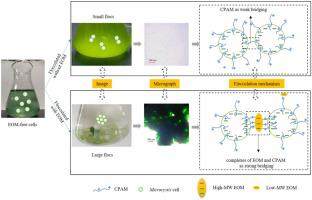Journal of Water Process Engineering ( IF 6.3 ) Pub Date : 2021-04-02 , DOI: 10.1016/j.jwpe.2021.102053 Qijia Cai , Kezheng Song , Cuicui Tian , Xingqiang Wu , Yang Li , Yuhong Huang , Chunbo Wang , Bangding Xiao

|
Flocculation-filtration treatment with cationic polymers and a rotary drum filter is an effective method to control Microcystis bloom by separating Microcystis from water. However, flocculation and corresponding removal are significantly affected by dissolved organic matters, of which extracellular organic matter (EOM) of Microcystis is the main source during Microcystis blooms. Hence, this study investigated the effect of EOM on the removal of Microcystis by using flocculation with cationic polyacrylamide (CPAM) and filtration with 100-μm filter. Results showed that the removal efficiency increased with the growth of Microcystis and was attributed to the accumulated EOM. With EOM > 2.5 mg/L extracted from stationary growth period, the cells could form large flocs with CPAM, over 90 % of which could be detained by a 100-μm sieve. Scanning electron microscope images showed that EOM interacted with CPAM and formed complexes, which bridged between the cells more strongly. Meanwhile, the removal was affected by EOM characteristics and had a positive correlation with the proportion of protein and polysaccharide in the EOM, which were usually regarded as polymers. The high-molecular weight (MW > 30 kDa) fraction was thus identified as an effective component in EOM to facilitate the formation of large and compact flocs, especially the fraction with MW > 100 kDa. This study partly revealed the differences in the removal efficiency of Microcystis from the perspective of the concentration and characteristic of EOM, and aid the understanding of the interaction between CPAM and high-MW EOM fraction for the formation of large and compact flocs.
中文翻译:

通过絮凝和过滤从水体中收获微囊藻:细胞外有机物的重要作用
用阳离子聚合物和转鼓式过滤器进行絮凝-过滤处理是通过将微囊藻与水中分离来控制微囊藻开花的有效方法。然而,絮凝和相应的去除受到溶解的有机物的显着影响,其中微囊藻的细胞外有机物(EOM)是微囊藻开花期间的主要来源。因此,本研究通过使用阳离子聚丙烯酰胺(CPAM)絮凝并用100-μm滤器过滤来研究EOM对微囊藻的去除效果。结果表明,去除效率随着微囊藻的生长而增加。并归因于累积的EOM。当从静止生长期提取的EOM> 2.5 mg / L时,细胞可以用CPAM形成大絮状物,其中90%以上可以用100μm的筛子截留。扫描电子显微镜图像显示,EOM与CPAM相互作用并形成复合物,复合物在细胞之间的连接更牢固。同时,去除受到EOM特性的影响,并且与EOM中蛋白质和多糖的比例呈正相关,而EOM中的蛋白质和多糖通常被认为是聚合物。因此,高分子量(MW> 30 kDa)馏分被确定为EOM中促进形成大而致密絮状物的有效成分,尤其是MW> 100 kDa的馏分。这项研究部分揭示了微囊藻的去除效率的差异 从EOM的浓度和特性的角度出发,有助于理解CPAM和高分子量EOM馏分之间的相互作用,从而形成大而致密的絮凝物。











































 京公网安备 11010802027423号
京公网安备 11010802027423号